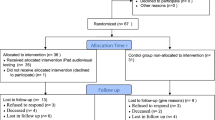Abstract
This study assessed patients' experiences using a computerized program with a touch-sensitive video monitor (TSVM) for the assessment of health-related quality of life (HRQoL). A software program was developed for a computerized form of the European Organization for Research and Treatment of Cancer Quality of Life Questionnaire, the QLQ-C30. One hundred and seventy-eight patients completed the QLQ-C30, followed by a structured interview designed to assess perceived difficulties with the use of the TSVM. Patients were asked to evaluate the ease of use of different aspects of the TSVM system (using the touch-sensitive screen, entering the patient identification number, reading the screen and following the on-screen instructions). The majority of patients found all aspects of the TSVM system ‘very easy’ to use. A few patients (1–2%) admitted finding any aspect of the TSVM use ‘somewhat difficult’ and none ranked any aspect as ‘very difficult’. There were no unanswered items in the QLQ-C30. All patients found the amount of time spent on answering the questionnaire acceptable, (the mean time to complete was 6.8 min with a median of 5 min) and 96% stated they were willing to complete a similar questionnaire on a future occasion. From the patients' perspective the TSVM system appears to be a highly acceptable approach for the collection of HRQoL data in clinical practice.
Similar content being viewed by others
References
Aaronson NK, Ahmedzai S, Bergman B, Bullinger M, Cull A, Duez NJ, et al. The European Organization for Research and Treatment of Cancer QLQ C-30: a quality of life instrument for use in international trials in clinical oncology. J Natl Cancer Inst 1993; 85(5): 365-376.
Wisloff F, Eika S, Hippe E, Hjorth M, Holmberg E, Kaasa S, et al.. The measurement of health-related quality of life in multiple myeloma. Nordic Myeloma Study Group. Br J Haematol 1996; 92(3): 604-613.
Osoba D, Zee B, Pater J, Warr D, Kaizer L, Latreille J. Psychometric properties and responsiveness of the EORTC Quality of Life Questionnaire (QLQ-C30) in patients with breast, ovarian and lung cancer. Qual Life Res 1994; 3(5): 353-364.
Kaasa S, Bjordal K, Aaronson N, Moum T, Wist E, Hagen S, et al. The EORTC core quality of life questionnaire (QLQ-C30): validity and reliability when analysed with patients treated with palliative radiotherapy. Eur J Cancer 1995; 31A(13–14): 2260-2263.
Together We Can. BC Cancer Agency, BC Cancer Research Centre and BC Cancer Foundation Annual Report 1995–1996. Ed. Libby Brown. Vancouver: BC Cancer Agency; 1996.
Brorsson B, Ifver J, Hays RD. The Swedish Health-Related Quality of Life Survey. Qual Life Res 1993; 2(1): 33-45.
Author information
Authors and Affiliations
Rights and permissions
About this article
Cite this article
Buxton, J., White, M. & Osoba, D. Patients' experiences using a computerized program with a touch-sensitive video monitor for the assessment of health-related quality of life.. Qual Life Res 7, 513–519 (1998). https://doi.org/10.1023/A:1008826408328
Issue Date:
DOI: https://doi.org/10.1023/A:1008826408328



